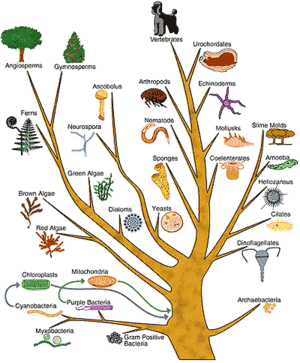Patterns in Macroevolution
Fossils
- Trace of any organism that lived in the past

- 99% extinct, used as evidence for evolution
- Law of Succession: resemblance between living and fossil forms in the same region
Relative Dating
- Fossils formed in sedimentary rock in which the sediments form layers that differ in colour, thickness and composition
- Principle of superposition: Younger rocks are deposited on older rocks
- Relative place of fossils determines relative age of fossils
- Radiometric dating gives absolute age
- Limitations to record (fossilization depends on the nature of the specimen, soft things are less durable, better fossilizations occurs when there is less oxygen)
Modes of Evolution
Anagenesis
- Accumulation of changes in a lineage as it adapts to changing environments
- If changes are significant, may warrant naming a new species
- Does not increase number if species over time
Cladogenesis
- Evolution of two or more descendent species from a common ancestor
- Should increase number of species over time
- Evidence by coexisting or overlapping fossil forms
Tempo of Evolution
- Gradualism: Large differences in species represent the culmination of many small changes (should see transitional forms in fossil record).
- Punctuated Equilibrium: Species diverge in spurts of rapid change, followed by long periods of ‘stasis’ (really rapid, huge change followed by nothing).
Sexual Selection
| Advantages of Sexual Reproduction | Disadvantages of Sexual Reproduction |
| 1. Reversing Muller’s Ratchet
-Recombination generates offspring with possibly fewer mutations than parent (could also be more or same) 2. The Lottery Model -Higher probability favourable trait will be selected & offspring will survive |
1.Energy wasted on mating rituals
2.Can’t produce offspring without mate 3.Only pass half of your genes |
Sexual Selection: Differential reproductive success due to variation among individuals in success at getting mates
i) Intrasexual selection -> Males monopolize access to females
- Direct control of females
- Control of a resource important to females
- Types of competition:
- Combat (size dimorphism, aggression, weaponry, complex songs, agility)
- Sperm competition (copulatory plugs, hooked heads, guard females post cop.)
- Infanticide (kill babies of other males)
ii) Intersexual selection -> Females choose mates based on displays
- Leads to elaborate displays/calls, ornamentation
- Females are choosier because mothers make a larger parental investment in offspring than fathers
- Males fitness limited by mates
- Females motivated by quality not quantity
Speciation
Microevolution: Changes in allele frequencies
Macroevolution: The origin of new taxonomic groups
Morphological Species Concept: If they look the same, then are most likely interbreed with each
Biological Species Concept: groups of potentially or actually interbreeding organisms, reproductively isolated from one another by gene pool
Reproductive Isolation
Pre-zygotic
- Ecological – living in different habitats
- Temporal – ‘active’ at different times
- Behaviour – have unique courtship
- Mechanical – incompatible reproductive structures
- Gametic – incompatible sperm and eggs
Post-zygotic
- Hybrid inviability – embryo fails to develop
- Hybrid sterility – offspring are infertile (mule)
- Hybrid Breakdown – F2 generation infertile
Ring Species
- Ring shaped distribution due to inhabitable terrain in the centre
- Gene flow between distant populations through intermediary populations
Phylogenetic Species Concept: the smallest group of organisms that share a unique set of traits NOT shared by any other groups (‘monophyletic’)
- Traits: morphological, behavioral, genetic…
- Populations must have been evolutionary independent long enough
Mechanisms of Speciation
Allopatric Speciation: A physical barrier subdivides a population
a) Long distance dispersal (and founder affect)
b) Vicariance – formation of a geographic barrier
Secondary Contact: Opportunity to determine if divergence was sufficient to cause reproductive isolation
Reinforcement: Natural selection may favour isolation if hybrid has a lower fitness
Parapatric Speciation: Population spreads across a heterogeneous landscape; Different selection in adjacent habitats
Sympatric Speciation: Divergence within a homogeneous environment
a) Polyploidy – errors in mitosis causing extra sets of chromosomes
b) Disruptive Selection with Assortative mating – (ex: a species of birds dimorphic for beak size mate selectively with similar morphs)

